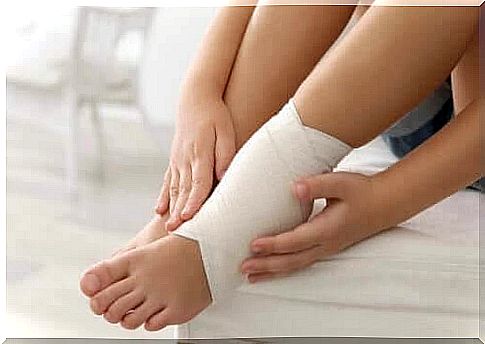Swollen Ankles And Feet: 5 Good Treatments

Before choosing a treatment for your swollen ankles and feet, it is important that you first find out the cause of the problem.
Does it have anything to do with the ligaments? Are you not able to move properly? If this is the case then please contact your doctor. If, on the other hand, it is just a minor injury, or if it is due to fluid retention, then you should try one of the treatment methods in this article.
Swollen ankles and feet often occur in the elderly and pregnant women. However, it is also normal in athletes as well as individuals whose work involves a great deal of physical effort. Although it can be due to poor blood circulation, trauma and infections, swelling is almost always mild and can be improved if you take the necessary precautions.
Treatment of swollen ankles and feet
First of all, you need to determine how severe your symptoms are before trying these tips to relieve your swollen ankles and feet. If it’s a specific type of swelling – the kind that occurs after sitting in the same position for a while – then some simple exercises and basic care will suffice.
However, if your symptoms persist or you have pain, have difficulty walking and there are signs, then you should contact your doctor who can advise you on the correct treatment. The doctor should be able to determine what is wrong after he or she has performed a physical examination as well as taken x-rays.
In this article, we give you some tips on treatment methods so that swollen ankles and feet will be a thing of the past.

1. Lift your legs up
The best exercise to relieve swollen ankles and feet is to lift your legs up above heart level. This simple movement improves blood circulation from the lower extremities to the heart, which in turn reduces swelling.
It is an excellent way to achieve quick relief if your feet are asleep or if you are experiencing pain.
Here’s how you do it
- Lie down on a comfortable surface, which can be a sofa or a yoga mat, for example. Lift your legs up toward the ceiling.
- Keep your legs lifted for 10 to 15 minutes.
2. Exercise
Moderate exercise has therapeutic effects on lesions leading to ankle swelling. In fact, it is one of the best habits you can get as it reactivates your blood circulation. It also prevents fluid retention.
The World Health Organization (WHO) recommends that you exercise at least a few hours a week.
Here’s how you do it
- Talk to your doctor or physiotherapist about the exercises that will be best in your case if you are suffering from an ankle injury.
- Avoid high-intensity routines until your injury is healed.
- Choose moderate activities such as walking or swimming. You can also stretch using elastic bands.

3. Rest reduces swollen ankles and feet
Although moderate exercise helps relieve swollen ankles and feet, it is also healthy to rest for a few days. Rest reduces the pressure that your body weight puts on your ankles. It also contributes to muscle relaxation and promotes recovery in the affected tissue.
Here’s how you do it
- If you have recently had an injury or a sprained ankle, it is important that you rest for 2-3 days.
- If you feel pain when resting on your foot, use crutches.
- If the swelling is due to high-intensity physical activity, just rest.
4. Use ice
It can be very helpful to use ice cream (such as a bag of frozen peas) when treating swollen ankles and feet. The cold temperature has a therapeutic effect as it reduces the level of inflammation. Its use with the help of massage will speed up the pain relief, while reducing bruising and muscle spasms.
Here’s how you do it
- Take a bag of frozen peas or other things you have in the freezer. Wrap the bag in a tea towel.
- Gently massage your ankle against the bag.
- Keep going until you can no longer feel anything on your ankle. Then rest your ankle / foot for 2-4 hours, after which you repeat the process.
- Continue this treatment for three or four days until the swelling is under control.

5. Apply bandage to your swollen ankles and feet
It can be a good solution to wrap the affected ankle or foot in bandage as a supplement to other treatments. Before wrapping the bandage around the ankle, you can massage the affected area with anti-inflammatory oil or cream. Keep the bandage on for two or more days – it depends on the intensity of the swelling.
Here’s how you do it
- Buy bandage at the pharmacy or other places that sell it.
- Wrap it around the swollen ankle or foot.
- Make sure it is not too tight. It must not interfere with blood flow as this will aggravate the swelling.
Finally, you should make an effort to improve your diet and avoid eating too much salt. Salt can inhibit any type of treatment as it increases fluid retention. Likewise, drink plenty of water and avoid alcohol and tobacco.









